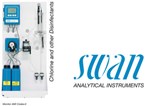Water Plant Applies Colorimetric Chlorine Analyzer To Accurately Measure Proper Chloramination

By Kevin Forsman
The North Shore Water Commission located in Glendale Wisconsin is a conventional water treatment facility that receives its influent from Lake Michigan. At the intake, chemical treatment is applied for mussel control and the water is pumped to the treatment plant 1 mile away.
At the plant, alum and polymer are added to promote settling and then the water travels through rectangular settling basins and finally directed to rapid sand filters.
After filtration, the water is pumped through a UV disinfection system and after the UV reactors, sodium hypochlorite is used to disinfect any remaining pathogens. The water is then directed to reservoirs to ensure proper chlorine disinfection.
After the reservoir, free chlorine is measured right before ammonium hydroxide (ammonia) is added. Ammonia is flow paced and is adjusted to the free chlorine residual to achieve a constant chlorine to ammonia ratio. The ammonia control strategy is to achieve a 4.5 to 1 weight ratio of chlorine to ammonia using free chlorine residual and the assay of ammonium hydroxide.
Get unlimited access to:
Enter your credentials below to log in. Not yet a member of Water Online? Subscribe today.
